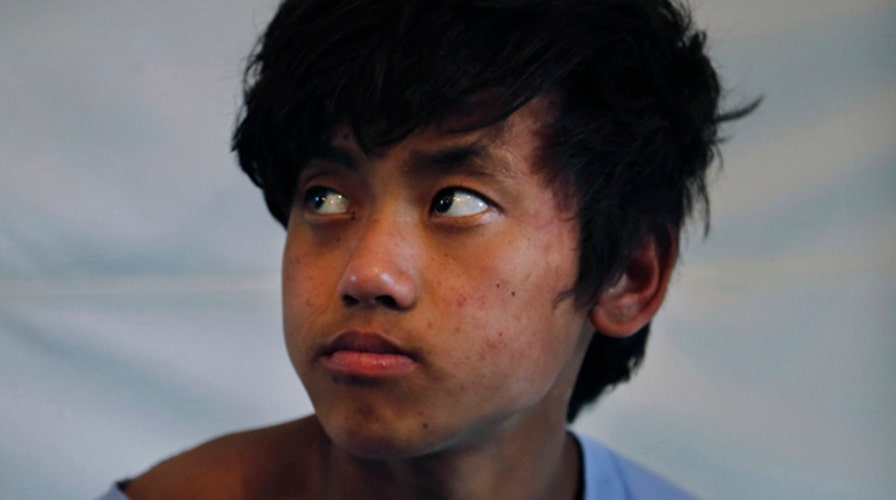A teenage boy was pulled, dazed and dusty, from the wreckage of a seven-story building in Kathmandu Thursday that collapsed around him five days ago when an enormous earthquake rocked Nepal.
Pemba Tamang, 15, was carried out on a stretcher with his face covered with dust. Medics had to put an IV drop into his arm and a blue brace had been placed around his neck. He appeared stunned and his eyes blinked in the sunlight.
Nepalese rescuers, with support from an American disaster response team, had been working for hours to free Tamang from the rubble.
L.B. Basnet, the police officer who crawled into a gap in the rubble to reach the teen, said he was surprisingly responsive.
"He thanked me when I first approached him," said Basnet. "He told me his name, his address, and I gave him some water. I assured him we were near to him."
Rescuers eventually used jacks to lift the concrete slabs that had wedged him in, said Basnet.
An American disaster response team had been helping the Nepalese.
"He's not too far down, but the floors have collapsed and he'd pancaked between them," Andrew Olvera, an urban search and rescue member with the U.S. Agency for International Development's Disaster Assistance Response Team, said shortly before the boy was freed.
Twisted ropes of steel reinforcing rods were all that stopped huge concrete slabs from falling onto the scene. Two concrete floors hung down in front of the building like curtains.
The whole operation is dangerous," Olvera said. "But it's risk versus gain. To save a human life, we'll risk almost anything."
An 11-year-old girl was also pulled out from underneath the rubble on Thursday, according to the Nepali Times.
The girl spent 90 hours under debris in the town of Bhaktapur before being pulled out by Nepal's army.
Over the weekend, a 4-month-old baby boy was found alive after being buried under a collapsed building in Bhaktapur for 22 hours, the Kathmandu Today newspaper revealed Wednesday.
Images published by the newspaper showed the boy covered in dust and being pulled to safety by Nepal's army. The boy was taken to a local hospital and was cleared of injuries.
The rescues were a rare bit of good news in a city that has known little but despair since the earthquake hit.
Asked how Tamang had lasted for so many days, Basnet replied: "He survived by good faith."
On a drizzly, chilly day in Kathmandu Thursday, many residents remained on edge over aftershocks that have rattled the city. Saturday's mammoth quake killed more than 5,800 people and destroyed thousands of houses and other buildings.
More than 70 aftershocks stronger than magnitude 3.2 have been recorded in the Himalayan region by Indian scientists over the past five days, according to J.L. Gautam, the director of seismology at the Indian Meteorological Department in New Delhi. The strongest, registering magnitude 6.9, came on Sunday, he said.
Rattled by the shaking and anxious to check on family members in outlying areas, tens of thousands of people have left the capital on buses this week. The government has been providing free bus service to many destinations.
"I have to get home. It has already been so many days," said Shanti Kumari, with her 7-year-old daughter, who was desperate to see family in her home village in eastern Nepal. "I want to get at least a night of peace."
Five days after the quake, tent cities in Kathmandu had thinned out, as overnight rainfall persuaded many people to return to their homes, even if they were damaged by the quake. The streets of the capital were slick with rain Thursday morning, the potholes were filled with water.
Still, life in the capital was slowly returning to the way it had been before the quake. Small snack shops were open. At a leather goods shop, a merchant brushed dust from a jacket on display. A man laid out carpets and rugs beneath an awning at a handicrafts store. Foreigners stood in line at a cellphone store.
"It's getting back to normal, but we're still feeling aftershocks. It still doesn't feel safe," said Prabhu Dutta, a 27-year-old banker from Kathmandu. He said he felt four aftershocks in the morning, including one that rattled the sliding glass doors of the bookshelf in his bedroom —"My morning wakeup notice," he said.
Dutta has been sleeping in his home, which has some cracks in the wall, for two nights, but the dozens of small aftershocks that he has felt since Saturday's huge quake make him uneasy. "I am worried about whether they will continue for a long time or whether it will calm down."
Gautam of the Indian Meteorological Department, said the aftershocks could continue for long periods.
"We can expect aftershocks over the next few weeks, or months, or even years," he said. "These aftershocks are quite normal after a powerful earthquake of such magnitude."
There was no way, however, for seismologists to predict when the "next big one" would occur, he said.
Dutta said some people are returning to work, including at his bank, but that it was impossible to concentrate. "We roam around the office. We only have one topic of conversation: the earthquake."
Many people in Kathmandu are going to the country fearing that a big aftershock is coming, he said.
The Associated Press contributed to this report.

